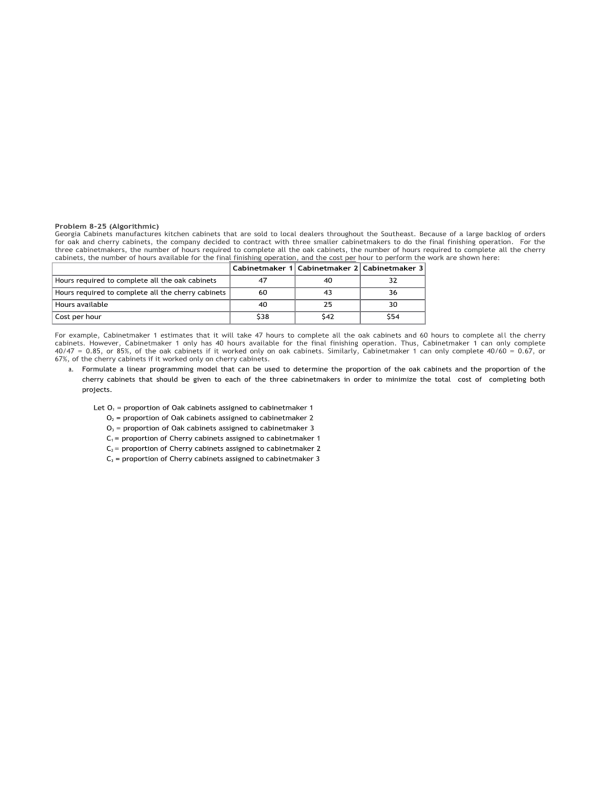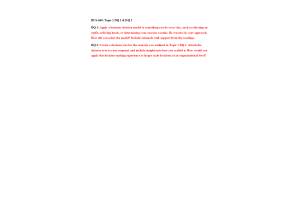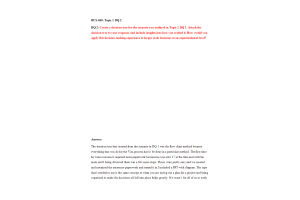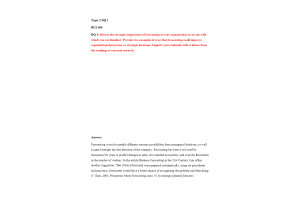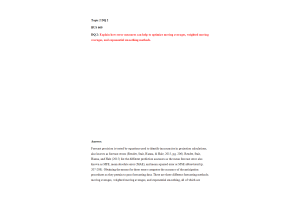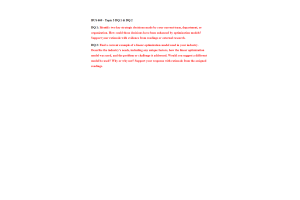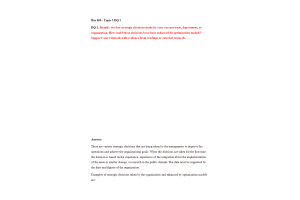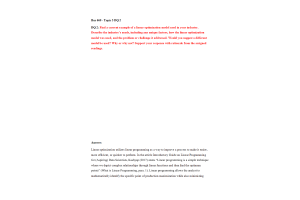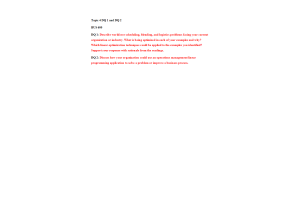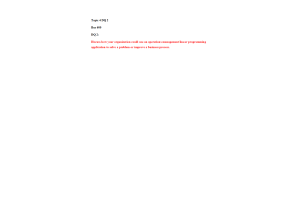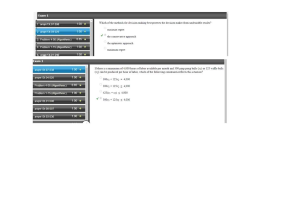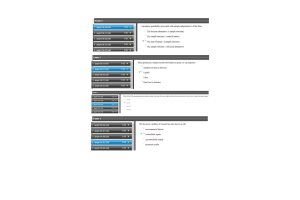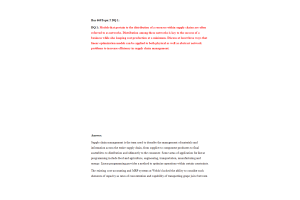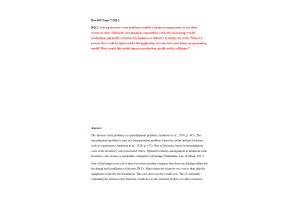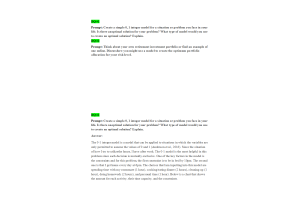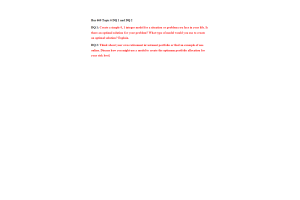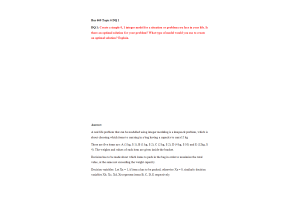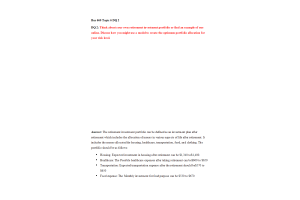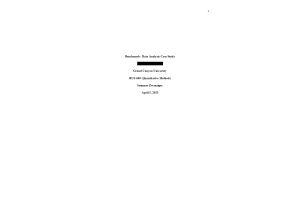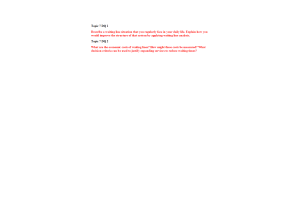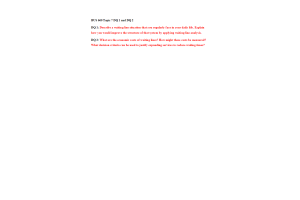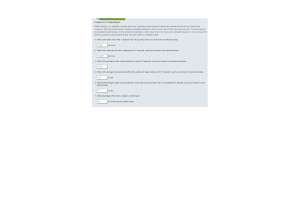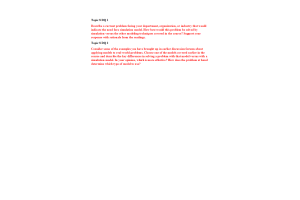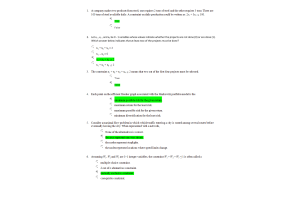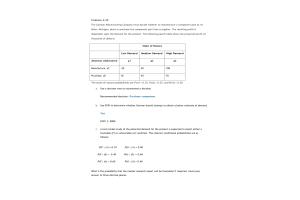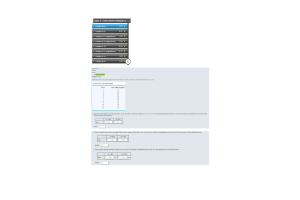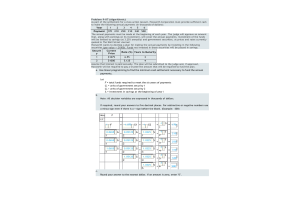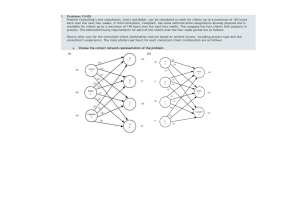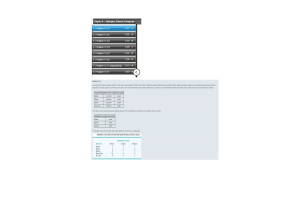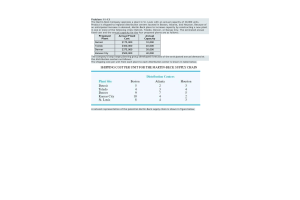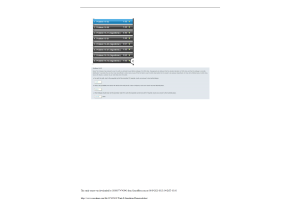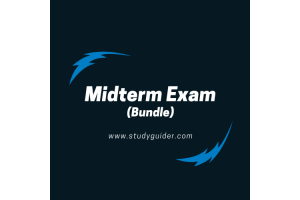BUS 660 Topic 3 Introduction to Linear Programming - Homework
- $29.00
Problem 8-25 (Algorithmic)
Georgia Cabinets manufactures kitchen cabinets that are sold to local dealers throughout the Southeast. Because of a large backlog of orders for oak and cherry cabinets, the company decided to contract with three smaller cabinetmakers to do the final finishing operation. For the three cabinetmakers, the number of hours required to complete all the oak cabinets, the number of hours required to complete all the cherry cabinets, the number of hours available for the final finishing operation, and the cost per hour to perform the work are shown here:
For example, Cabinetmaker 1 estimates that it will take 47 hours to complete all the oak cabinets and 60 hours to complete all the cherry cabinets. However, Cabinetmaker 1 only has 40 hours available for the final finishing operation. Thus, Cabinetmaker 1 can only complete 40/47 = 0.85, or 85%, of the oak cabinets if it worked only on oak cabinets. Similarly, Cabinetmaker 1 can only complete 40/60 = 0.67, or 67%, of the cherry cabinets if it worked only on cherry cabinets.
- Formulate a linear programming model that can be used to determine the proportion of the oak cabinets and the proportion of the cherry cabinets that should be given to each of the three cabinetmakers in order to minimize the total cost of completing both projects.
- Solve the model formulated in part (a). What proportion of the oak cabinets and what proportion of the cherry cabinets should be assigned to each cabinetmaker? What is the total cost of completing both projects? If required, round your answers for the proportions to three decimal places, and for the total cost to two decimal places.
- If Cabinetmaker 1 has additional hours available, would the optimal solution change?
- If Cabinetmaker 2 has additional hours available, would the optimal solution change?
- Suppose Cabinetmaker 2 reduced its cost to $39 per hour. What effect would this change have on the optimal solution? If required, round your answers for the proportions to three decimal places, and for the total cost to two decimal places.
Problem 8-19
Better Products, Inc., manufactures three products on two machines. In a typical week, 40 hours are available on each machine. The profit contribution and production time in hours per unit are as follows:
Two operators are required for machine 1; thus, 2 hours of labor must be scheduled for each hour of machine 1 time. Only one operator is required for machine 2. A maximum of 100 labor- hours is available for assignment to the machines during the coming week. Other production requirements are that product 1 cannot account for more than 50% of the units produced and that product 3 must account for at least 20% of the units produced.
- How many units of each product should be produced to maximize the total profit contribution? What is the projected weekly profit associated with your solution?
- How many hours of production time will be scheduled on each machine? If required, round your answers to two decimal places.
- What is the value of an additional hour of labor? If required, round your answers to two decimal places.
- Assume that labor capacity can be increased to 120 hours. Develop the optimal product mix, assuming that the extra hours are made available.Would you be interested in using the additional 20 hours available for this resource?
Problem 7-49 (Algorithmic)
PharmaPlus operates a chain of 30 pharmacies. The pharmacies are staffed by licensed pharmacists and pharmacy technicians. The company currently employs 85 full-time-equivalent pharmacists (combination of full time and part time) and 175 full-time-equivalent technicians. Each spring management reviews current staffing levels and makes hiring plans for the year. A recent forecast of the prescription load for the next year shows that at least 250 full-time-equivalent employees (pharmacists and technicians) will be required to staff the pharmacies. The personnel department expects 10 pharmacists and 30 technicians to leave over the next year. To accommodate the expected attrition and prepare for future growth, management states that at least 15 new pharmacists must be hired. In addition, PharmaPlus’s new service quality guidelines specify no more than two technicians per licensed pharmacist. The average salary for licensed pharmacists is $40 per hour and the average salary for technicians is $10 per hour.
- Determine a minimum-cost staffing plan for PharmaPlus. How many pharmacists and technicians are needed?
- Given current staffing levels and expected attrition, how many new hires (if any) must be made to reach the level recommended in part (a)? What will be the impact on the payroll?
Problem 7-15
Par, Inc., is a small manufacturer of golf equipment and supplies. Par’s distributor believes a market exists for both a medium-priced golf bag, referred to as a standard model, and a high-priced golf bag, referred to as a deluxe model. The distributor is so confident of the market that, if Par can make the bags at a competitive price, the distributor will purchase all the bags that Par can manufacture over the next three months. A careful analysis of the manufacturing requirements resulted in the following table, which shows the production time requirements for the four required manufacturing operations and the accounting department’s estimate of the profit contribution per bag:
The director of manufacturing estimates that 630 hours of cutting and dyeing time, 600 hours of sewing time, 708 hours of finishing time, and 135 hours of inspection and packaging time will be available for the production of golf bags during the next three months.
Select the correct graph that shows the optimal solution if Par's management encounters the following independent situations:
- The accounting department revises its estimate of the profit contribution for the deluxe bag to $18 per bag.
- A new low-cost material is available for the standard bag, and the profit contribution per standard bag can be increased to $20 per bag. (Assume that the profit contribution of the deluxe bag is the original $9 value.)
- New sewing equipment is available that would increase the sewing operation capacity to 750 hours. (Assume that 10A + 9B is the appropriate objective function.)
Problem 7-41
Southern Oil Company produces two grades of gasoline: regular and premium. The profit contributions are $0.30 per gallon for regular gasoline and $0.50 per gallon for premium gasoline. Each gallon of regular gasoline contains 0.3 gallons of grade A crude oil and each gallon of premium gasoline contains 0.6 gallons of grade A crude oil. For the next production period, Southern has 18,000 gallons of grade A crude oil available. The refinery used to produce the gasolines has a production capacity of 50,000 gallons for the next production period. Southern Oil's distributors have indicated that demand for the premium gasoline for the next production period will be at most 20,000 gallons.
- Formulate a linear programming model that can be used to determine the number of gallons of regular gasoline and the number of gallons of premium gasoline that should be produced in order to maximize total profit contribution. If required, round your answers to two decimal places.
Let R = number of gallons of regular gasoline produced
P = number of gallons of premium gasoline produced
- What is the optimal solution?
- What are the values and interpretations of the slack variables?
- What are the binding constraints?
Problem 7-25 (Algorithmic)
George Johnson recently inherited a large sum of money; he wants to use a portion of this money to set up a trust fund for his two children. The trust fund has two investment options: (1) a bond fund and (2) a stock fund. The projected returns over the life of the investments are 6% for the bond fund and 10% for the stock fund. Whatever portion of the inheritance George finally decides to commit to the trust fund, he wants to invest at least 30% of that amount in the bond fund. In addition, he wants to select a mix that will enable him to obtain a total return of at least 7.5%.
a. Formulate a linear programming model that can be used to determine the percentage that should be allocated to each of the possible investment alternatives. If required, round your answers to three decimal places.
c. Solve the problem using the graphical solution procedure. If required, round the answers to one decimal place.
Problem 8-21 (Algorithmic)
Round Tree Manor is a hotel that provides two types of rooms with three rental classes: Super Saver, Deluxe, and Business. The profit per night for each type of room and rental class is as follows:
Type I rooms do not have wireless Internet access and are not available for the Business rental class.
Round Tree's management makes a forecast of the demand by rental class for each night in the future. A linear programming model developed to maximize profit is used to determine how many reservations to accept for each rental class. The demand forecast for a particular night is 125 rentals in the Super Saver class, 50 rentals in the Deluxe class, and 40 rentals in the Business class. Round Tree has 110 Type I rooms and 120 Type II rooms.
- Use linear programming to determine how many reservations to accept in each rental class and how the reservations should be allocated to room types.
Is the demand by any rental class not satisfied?
- How many reservations can be accommodated in each rental class?
- Management is considering offering a free breakfast to anyone upgrading from a Super Saver reservation to Deluxe class. If the cost of the breakfast to Round Tree is $5, should this incentive be offered?
- With a little work, an unused office area could be converted to a rental room. If the conversion cost is the same for both types of rooms, would you recommend converting the office to a Type I or a Type II room?
- Could the linear programming model be modified to plan for the allocation of rental demand for the next night?
Problem 8-29 (Algorithmic)
La Jolla Beverage Products is considering producing a wine cooler that would be a blend of a white wine, a rose wine, and fruit juice. To meet taste specifications, the wine cooler must consist of at least 45% white wine, at least 20% and no more than 35% rose, and exactly 25% fruit juice. La Jolla purchases the wine from local wineries and the fruit juice from a processing plant in San Francisco. For the current production period, 10000 gallons of white wine and 6500 gallons of rose wine can be purchased; an unlimited amount of fruit juice can be ordered. The costs for the wine are $1 per gallon for the white and $1.5 per gallon for the rose; the fruit juice can be purchased for $0.5 per gallon. La Jolla Beverage Products can sell all of the wine cooler it can produce for $3 per gallon.
- Is the cost of the wine and fruit juice a sunk cost or a relevant cost in this situation?
- Formulate a linear program to determine the blend of the three ingredients that will maximize the total profit contribution. Solve the linear program to determine the number of gallons of each ingredient La Jolla should purchase and the total profit contribution it will realize from this blend. If required, round your answers to one decimal place. For subtractive or negative numbers use a minus sign even if there is a + sign before the blank.
- If La Jolla could obtain additional amounts of the white wine, should it do so?
- If La Jolla Beverage Products could obtain additional amounts of the rosé wine, should it do so?
- Interpret the shadow price for the constraint corresponding to the requirement that the wine cooler must contain at least 50% white wine. What is your advice to management given this shadow price?
- Interpret the shadow price for the constraint corresponding to the requirement that the wine cooler must contain exactly 20% fruit juice. What is your advice to management given this shadow price?
